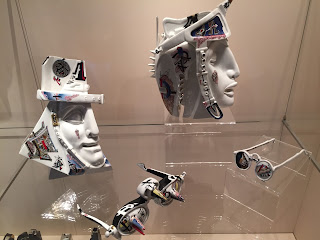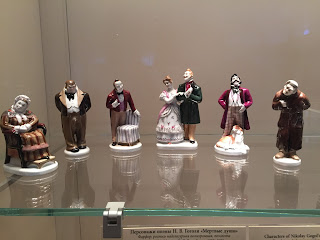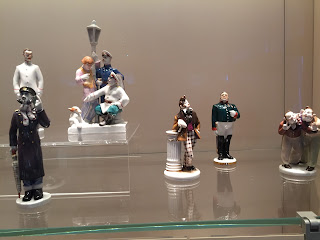43. The Imperial Porcelain Factory Museum
Although this is yet another branch of the Hermitage Museum (the fifth I've visited, with just one more to go), the Imperial Porcelain Factory Museum is located well outside of the city center. It's right on the banks of the Neva River but four Metro stops southeast of Nevsky Prospekt.
The Imperial Porcelain Factory has been active since the middle of the 18th century. I've seen a bunch of their work from the 18th and 19th centuries in the collections of the Hermitage Winter Palace, Russian State Museum, and various other palaces. The factory museum has over 30,000 works in its collection, spanning the entire operational history of the plant. The factory has manufactured a variety of items in the last 273 years: Vases, statues, figurines, plates, cups, and sculptures in a myriad of forms ranging from utilitarian to wildly imaginative.
I was expecting a sprawling complex that exhaustively catalogued centuries worth of ceramic production, but the reality was more modest. There were only three rooms with items on display - hundreds of sculptures in each room, but this is really just a 45-60 minute visit. In fact, it's not a museum in the true sense of the word - there was no interpretation and not much curation, either. No signs, no explanatory text anywhere besides a brochure available at the ticket desk (Russian language only), no audio guides or tours, and in some cases no discernible pattern as to why certain objects were grouped together in the same display case. I was expecting an emphasis on the "factory" part of the institution's name: videos showing the production process, a window overlooking the artisans hard at work, a balcony with a view of the kilns - anything, really. This was not the case. The well-stocked gift shop (the Imperial Porcelain Factory is still an active production facility, after all) included objects for sale that were duplicates of older sculptures that were displayed in the museum. "Art Gallery" might be more appropriate designation, given the emphasis on commerce rather than education.
Even though many of the individual pieces are spectacular, this museum can be skipped by everyone other than die-hard ceramics aficionados. There are several official Imperial Porcelain stores in the city center that sell the same range of goods as the on-premise store, and the historical output of the factory is generously represented in other local museum collections that are a bit more convenient to reach. So, there was nothing novel to see here, with the exception of a greater proportion of 20th century works produced during the Soviet era. Not worth the detour in my opinion, other than the fact that I'm trying to go everywhere of note in St. Petersburg.
I took the following two pictures in the gift shop. It's hard to tell the difference from the preceding images without this caption, I think. I liked the figurines that were for sale (at a dear price) more than many of the figurines on display in the galleries.
The Imperial Porcelain Factory has been active since the middle of the 18th century. I've seen a bunch of their work from the 18th and 19th centuries in the collections of the Hermitage Winter Palace, Russian State Museum, and various other palaces. The factory museum has over 30,000 works in its collection, spanning the entire operational history of the plant. The factory has manufactured a variety of items in the last 273 years: Vases, statues, figurines, plates, cups, and sculptures in a myriad of forms ranging from utilitarian to wildly imaginative.
I was expecting a sprawling complex that exhaustively catalogued centuries worth of ceramic production, but the reality was more modest. There were only three rooms with items on display - hundreds of sculptures in each room, but this is really just a 45-60 minute visit. In fact, it's not a museum in the true sense of the word - there was no interpretation and not much curation, either. No signs, no explanatory text anywhere besides a brochure available at the ticket desk (Russian language only), no audio guides or tours, and in some cases no discernible pattern as to why certain objects were grouped together in the same display case. I was expecting an emphasis on the "factory" part of the institution's name: videos showing the production process, a window overlooking the artisans hard at work, a balcony with a view of the kilns - anything, really. This was not the case. The well-stocked gift shop (the Imperial Porcelain Factory is still an active production facility, after all) included objects for sale that were duplicates of older sculptures that were displayed in the museum. "Art Gallery" might be more appropriate designation, given the emphasis on commerce rather than education.
Even though many of the individual pieces are spectacular, this museum can be skipped by everyone other than die-hard ceramics aficionados. There are several official Imperial Porcelain stores in the city center that sell the same range of goods as the on-premise store, and the historical output of the factory is generously represented in other local museum collections that are a bit more convenient to reach. So, there was nothing novel to see here, with the exception of a greater proportion of 20th century works produced during the Soviet era. Not worth the detour in my opinion, other than the fact that I'm trying to go everywhere of note in St. Petersburg.
I took the following two pictures in the gift shop. It's hard to tell the difference from the preceding images without this caption, I think. I liked the figurines that were for sale (at a dear price) more than many of the figurines on display in the galleries.








































Comments
Post a Comment